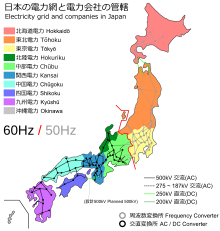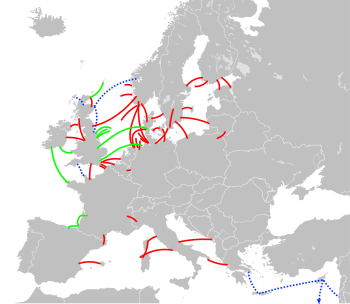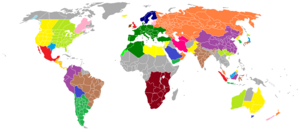Wide area synchronous grid
A wide area synchronous grid (also called an "interconnection" in North America) is a three-phase electric power grid that has regional scale or greater that operates at a synchronized utility frequency and is electrically tied together during normal system conditions. Also known as synchronous zones, the most powerful is the Northern Chinese State Grid with 1,700 gigawatts (GW) of generation capacity, while the widest region served is that of the IPS/UPS system serving most countries of the former Soviet Union. Synchronous grids with ample capacity facilitate electricity trading across wide areas. In the CESA system in 2008, over 350,000 megawatt hours were sold per day on the European Energy Exchange (EEX).[1]
Neighbouring interconnections with the same frequency and standards can be synchronized and directly connected to form a larger interconnection, or they may share power without synchronization via high-voltage direct current power transmission lines (DC ties), solid-state transformers or variable-frequency transformers (VFTs), which permit a controlled flow of energy while also functionally isolating the independent AC frequencies of each side. Each of the interconnects in North America is synchronized at a nominal 60 Hz, while those of Europe run at 50 Hz.
The benefits of synchronous zones include pooling of generation, resulting in lower generation costs; pooling of load, resulting in significant equalizing effects; common provisioning of reserves, resulting in cheaper primary and secondary reserve power costs; opening of the market, resulting in possibility of long term contracts and short term power exchanges; and mutual assistance in the event of disturbances.[2]
One disadvantage of a wide-area synchronous grid is that problems in one part can have repercussions across the whole grid.
Properties
[edit]Wide area synchronous networks improve reliability and permit the pooling of resources. Also, they can level out the load, which reduces the required generating capacity, allow more environmentally-friendly power to be employed; allow more diverse power generation schemes and permit economies of scale.[3]

Wide area synchronous networks cannot be formed if the two networks to be linked are running at different frequencies or have significantly different standards. For example, in Japan, for historical reasons, the northern part of the country operates on 50 Hz, but the southern part uses 60 Hz. That makes it impossible to form a single synchronous network, which was problematic when the Fukushima Daiichi plant melted down.
Also, even when the networks have compatible standards, failure modes can be problematic. Phase and current limitations can be reached, which can cause widespread outages. The issues are sometimes solved by adding HVDC links within the network to permit greater control during off-nominal events.
As was discovered in the 2000–2001 California electricity crisis, there can be strong incentives among some market traders to create deliberate congestion and poor management of generation capacity on an interconnection network to inflate prices. Increasing transmission capacity and expanding the market by uniting with neighbouring synchronous networks make such manipulations more difficult.
Frequency
[edit]In a synchronous grid, all the generators naturally lock together electrically and run at the same frequency, and stay very nearly in phase with each other. For rotating generators, a local governor regulates the driving torque and helps maintain a more or less constant speed as loading changes. Droop speed control ensures that multiple parallel generators share load changes in proportion to their rating. Generation and consumption must be balanced across the entire grid because energy is consumed as it is produced. Energy is stored in the immediate short term by the rotational kinetic energy of the generators.
Small deviations from the nominal system frequency are very important in regulating individual generators and assessing the equilibrium of the grid as a whole. When the grid is heavily loaded, the frequency slows, and governors adjust their generators so that more power is output (droop speed control). When the grid is lightly loaded the grid frequency runs above the nominal frequency, and this is taken as an indication by Automatic Generation Control systems across the network that generators should reduce their output.
In addition, there's often central control, which can change the parameters of the AGC systems over timescales of a minute or longer to further adjust the regional network flows and the operating frequency of the grid.
Where neighbouring grids, operating at different frequencies, need to be interconnected, a frequency converter is required. HVDC interconnectors, solid-state transformers or variable-frequency transformers links can connect two grids that operate at different frequencies or that are not maintaining synchronism.
Inertia
[edit]Inertia in a synchronous grid is stored energy that a grid has available which can provide extra power for up to a few seconds to maintain the grid frequency. Historically, this was provided only by the angular momentum of the generators, and gave the control circuits time to adjust their output to variations in loads, and sudden generator or distribution failures.
Inverters connected to HVDC usually have no inertia, but wind power can provide inertia, and solar and battery systems can provide synthetic inertia.[4][5]
Short circuit current
[edit]In short circuit situations, it's important for a grid to be able to provide sufficient current to keep the voltage and frequency reasonably stable until circuit breakers can resolve the fault. Many traditional generator systems had wires which could be overloaded for very short periods without damage, but inverters are not as able to deliver multiple times their rated load. The short circuit ratio can be calculated for each point on the grid, and if it is found to be too low, for steps to be taken to increase it to be above 1, which is considered stable.
Timekeeping
[edit]For timekeeping purposes, over the course of a day the operating frequency will be varied so as to balance out deviations and to prevent line-operated clocks from gaining or losing significant time by ensuring there are 4.32 million on 50 Hz, and 5.184 million cycles on 60 Hz systems each day.
This can, rarely, lead to problems. In 2018 Kosovo used more power than it generated due to a row with Serbia, leading to the phase in the whole synchronous grid of Continental Europe lagging behind what it should have been. The frequency dropped to 49.996 Hz. Over time, this caused synchronous electric clocks to become six minutes slow until the disagreement was resolved.[6]
Deployed networks
[edit]| Name | Countries | Covers/Notes | Organization/Company | Generation capacity | Yearly generation | Year/Refs |
|---|---|---|---|---|---|---|
| Northern Chinese State Grid | Northern China | State Grid Corporation of China | 1700 GW | 5830 TWh | 2020[7] | |
| Continental Europe Synchronous Area (CESA, formerly UCTE grid) | 35 countries in Europe and North Africa, serving 450 million | ENTSO-E | 859 GW | 2569 TWh | 2017[8] | |
| Eastern Interconnection | Eastern US (except most of Texas) and eastern Canada (except Quebec and Newfoundland and Labrador) | 610 GW | 1380 TWh | 2017[citation needed] | ||
| National Grid (India) | Serving over 1.4 billion people | Power Grid Corporation of India | 425 GW | 1844 TWh | 2023[citation needed] | |
| IPS/UPS | 8 countries of former Soviet Union and Mongolia, serving 210 million | 337 GW | 1285 TWh | 2005[9][10] | ||
| China Southern Power Grid | Southern China | 320 GW | 1051 TWh | 2019[11] | ||
| Western Interconnection | Western US, western Canada, and northern Baja California in Mexico | 265 GW | 883 TWh | 2015[12] | ||
| National Interconnected System (SIN) | Electricity sector in Brazil | 150 GW | 410 TWh (2007)[citation needed] | 2016 | ||
| Synchronous grid of Northern Europe | Nordic countries (Finland, Sweden-except Gotland, Norway and Eastern Denmark) serving 25 million people | 93 GW | 390 TWh | [citation needed] | ||
| National Grid (Great Britain) | Great Britain's synchronous zone, serving 65 million | National Grid plc | 83 GW (2018)[13] | 336 TWh | 2017[13] | |
| Iran National Grid | Iran and Armenia, serving 84 million people | 82 GW | 2019[14] | |||
| Southern African Power Pool | SAPP serves 9 out of 12 SADC countries and small regions of Angola, Malawi, and Tanzania | 80.9 GW | 289 TWh | 2020[15] | ||
| Texas Interconnection | Most of Texas; serves 24 million customers | Electric Reliability Council of Texas (ERCOT) | 78 GW | 352 TWh (2016)[16] | 2018[17] | |
| National Electricity Market | Australia's States and Territories except for Western Australia and the Northern Territory (Tasmania is part of it but not synchronised) | National Electricity Market | 50 GW | 196 TWh | 2018[18] | |
| Quebec Interconnection | Quebec | Hydro-Québec TransÉnergie | 42 GW | 184 TWh | [citation needed] | |
| Java-Madura-Bali System (JAMALI) | JAMALI System serves 7 provinces (West, East, and Central Java, Banten, Jakarta, Yogyakarta, and Bali), serving 49.4 million customers. (Part of ASEAN Power Grid project) | PLN | 40.1 GW (2020)[19] | 163 TWh (2017)[20] | 2021 | |
| Argentine Interconnection System | Argentina except Tierra del Fuego | 39.7 GW | 129 TWh | 2019[21] | ||
| National Electrical System | Main Chilean grid | 31.7 GW | 75.8 TWh | 2022[22] | ||
| Sumatera System | Sumatera System serves 8 provinces (North, West, South Sumatera, Aceh, Bengkulu, Lampung, Jambi, and Riau) and Bangka Island, serving 17 million customers. (Part of ASEAN Power Grid project) | PLN | 14.7 GW (2020)[23] | 32.1 TWh (2016)[23] | 2022[24] | |
| Irish Grid | Ireland and Northern Ireland. | EirGrid | 7.3 GW (2022)[25] | 29.6 TWh | 2020[26] | |
| SIEPAC | The Central American Electrical Interconnection System serves Costa Rica, El Salvador, Guatemala, Honduras, Nicaragua and Panama | 6.7 GW | 2020[27] | |||
| Khatulistiwa System | Sarawak state and the northwestern part of West Kalimantan (Part of ASEAN Power Grid project) | Heads of ASEAN Power Utilities/Authorities (HAPUA) | 5.5 GW | 2017[citation needed] | ||
| South West Interconnected System | Western Australia | 4.3 GW | 17.3 TWh | 2016[28] |
Historically, on the North American power transmission grid the Eastern and Western Interconnections were directly connected, and was at the time largest synchronous grid in the world, but this was found to be unstable, and they are now only DC interconnected.[29]
Planned
[edit]- Unified Smart Grid unification of the US interconnections into a single grid with smart grid features.
- SuperSmart Grid a similar mega grid proposal linking UCTE, IPS/UPS, and Mediterranean grid.
- ASEAN Power Grid plan to connect all ASEAN Grids. The first step is connecting all mainland ASEAN countries with Sumatra, Java, and Singapore Grid, then Borneo Island and Philippines.
DC interconnectors
[edit]
Interconnectors such as High-voltage direct current lines, solid-state transformers or variable-frequency transformers can be used to connect two alternating current interconnection networks which are not necessarily synchronized with each other. This provides the benefit of interconnection without the need to synchronize an even wider area. For example, compare the wide area synchronous grid map of Europe (in the introduction) with the map of HVDC lines (here to the right). Solid state transformers have larger losses than conventional transformers, but DC lines lack reactive impedance and overall HVDC lines have lower losses sending power over long distances within a synchronous grid, or between them.
Planned non-synchronous connections
[edit]The Tres Amigas SuperStation aims to enable energy transfers and trading between the Eastern Interconnection and Western Interconnection using 30GW HVDC Interconnectors.
See also
[edit]- High-voltage direct current (HVDC)
- Super grid
- European super grid
- Microgrid
- Smart grid
- Unified Smart Grid
- SuperSmart Grid
- Tres Amigas SuperStation
References
[edit]- ^ "EEX Market Monitor Q3/2008" (PDF). Leipzig: Market Surveillance (HÜSt) group of the European Energy Exchange. 30 October 2008. p. 4. Archived from the original (PDF) on 2011-07-10. Retrieved 2008-12-06.
- ^ Haubrich, Hans-Jürgen; Dieter Denzel (2008-10-23). "Characteristics of interconnected operation" (PDF). Operation of Interconnected Power Systems (PDF). Aachen: Institute for Electrical Equipment and Power Plants (IAEW) at RWTH Aachen University. p. 3. Archived from the original (PDF) on 2011-07-19. Retrieved 2008-12-06. (See "Operation of Power Systems" link for title page and table of contents.)
- ^ "Technical Aspects of Grid Interconnection" (PDF). Retrieved 2023-12-14.
- ^ "Inertia and the Power Grid: A Guide Without the Spin".
- ^ Inertia and the Power Grid: A Guide Without the Spin Paul Denholm, Trieu Mai, Rick Wallace Kenyon, Ben Kroposki, and Mark O’Malley National Renewable Energy Laboratory
- ^ "Serbia, Kosovo power grid row delays European clocks". Reuters. Mar 7, 2018.
- ^ "Grid business, SGCC". www.sgcc.com.cn. Retrieved 23 November 2021.
- ^ "ENTSO-E Statistical Factsheet 2017" (PDF). www.entsoe.eu. Retrieved 2 January 2019.
- ^ UCTE-IPSUPS Study Group (2008-12-07). Feasibility Study: Synchronous Interconnection of the IPS/UPS with the UCTE (Report). TEN-Energy programme of the European Commission. p. 2.
- ^ Sergei Lebed RAO UES (2005-04-20). "IPS/UPS Overview" (PDF). Brussels: UCTE-IPSUPS Study presentation. p. 4. Archived from the original (PDF) on 2011-07-28. Retrieved 2008-12-07.
- ^ "Grid business, CSG". www.eng.csg.cn. Retrieved 23 November 2021.
- ^ 2016 State of the Interconnection page 10-14 + 18-23. WECC, 2016. Archive
- ^ a b "Digest of UK Energy Statistics (DUKES): electricity". GOV.UK. July 28, 2022.
- ^ "Dalahoo Power Plant Adds 310 MW to Power Capacity". Eghtesad Online. 27 November 2019. Retrieved 2019-12-02.
- ^ "Annual Reports | Southern African Power Pool". www.sapp.co.zw. Retrieved 2022-12-21.
- ^ Ercot 2016 Lists ercot.com
- ^ "Quick facts" (PDF). www.ercot.com. 818.
- ^ "Electricity supply to regions of the National Electricity Market | Australian Energy Regulator". Archived from the original on 2019-02-09. Retrieved 2019-02-08.
- ^ Mulyana, Ridwan Nanda (2021-02-23). Perwitasari, Anna Suci (ed.). "PLN: Ada tambahan 3.000 MW pembangkit listrik di sistem Jawa-Madura-Bali tahun ini". kontan.co.id (in Indonesian). Retrieved 2021-04-24.
- ^ "Indonesia's Electricity Systems - Jawa-Madura-Bali System". Insights. synergy. 2017-04-28. Retrieved 2021-04-24.
- ^ "Informe anual 2019" [2019 Annual report]. portalweb.cammesa.com (in Spanish). Compañía Administradora del Mercado Mayorista Eléctrico Sociedad Anónima. 12 June 2020. Retrieved 2020-08-10.
- ^ "Sistema Eléctrico Nacional (SEN) I Coordinador Eléctrico Nacional (CEN)". Coordinador Eléctrico Nacional | Servimos a Chile con Energía (in European Spanish). 2018-07-30. Retrieved 2022-12-21.
- ^ a b "Indonesia's Electricity Systems – Sumatera Interconnected System". Insights. synergy. 2017-05-29. Retrieved 2022-11-26.
- ^ "PLN Operasikan Sistem Interkoneksi 150 kV Sumatera-Bangka". validnews.id (in Indonesian). Retrieved 2022-11-26.
- ^ "Generation capacity statement" (PDF). ltd.uk. Retrieved 21 September 2023.
- ^ "Wind Energy Powers Ireland to Renewable Energy Target". 28 Jan 2021.
- ^ "Central American Electrical Interconnection System (SIEPAC)" (PDF). IRENA. Retrieved 21 September 2023.
- ^ 2015/16 Facts and statistics Western Power
- ^ Cohn, Julie (January 2019). "When the Grid Was the Grid: The History of North America's Brief Coast-to Coast Interconnected Machine". Proceedings of the IEEE. 107 (1): 232–243. doi:10.1109/JPROC.2018.2880938. S2CID 58005728.


 French
French Deutsch
Deutsch

